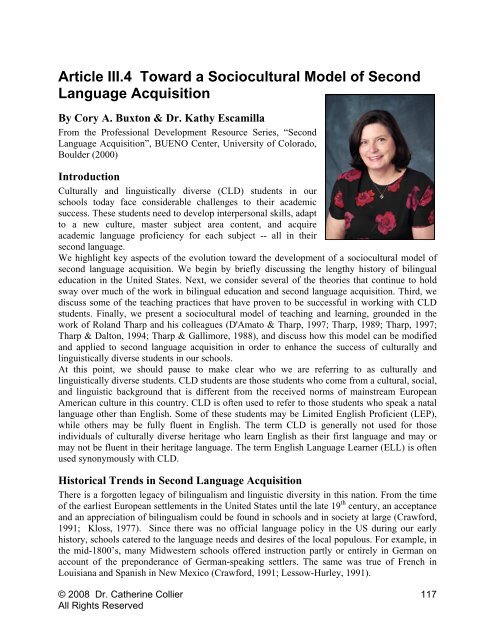Art Un ticle I.1 ited Sta In the ates News - Woodring College of ...
Art Un ticle I.1 ited Sta In the ates News - Woodring College of ...
Art Un ticle I.1 ited Sta In the ates News - Woodring College of ...
- No tags were found...
You also want an ePaper? Increase the reach of your titles
YUMPU automatically turns print PDFs into web optimized ePapers that Google loves.
<strong>Art</strong>icle III.4 Toward a Sociocultural Model <strong>of</strong> SecondLanguage AcquisitionBy Cory A. Buxton & Dr. Kathy EscamillaFrom <strong>the</strong> Pr<strong>of</strong>essional Development Resource Series, “SecondLanguage Acquisition”, BUENO Center, <strong>Un</strong>iversity <strong>of</strong> Colorado,Boulder (2000)<strong>In</strong>troductionCulturally and linguistically diverse (CLD) students in ourschools today face considerable challenges to <strong>the</strong>ir academicsuccess. These students need to develop interpersonal skills, adaptto a new culture, master subject area content, and acquireacademic language pr<strong>of</strong>iciency for each subject -- all in <strong>the</strong>irsecond language.We highlight key aspects <strong>of</strong> <strong>the</strong> evolution toward <strong>the</strong> development <strong>of</strong> a sociocultural model <strong>of</strong>second language acquisition. We begin by briefly discussing <strong>the</strong> lengthy history <strong>of</strong> bilingualeducation in <strong>the</strong> <strong>Un</strong><strong>ited</strong> <strong>Sta</strong>tes. Next, we consider several <strong>of</strong> <strong>the</strong> <strong>the</strong>ories that continue to holdsway over much <strong>of</strong> <strong>the</strong> work in bilingual education and second language acquisition. Third, wediscuss some <strong>of</strong> <strong>the</strong> teaching practices that have proven to be successful in working with CLDstudents. Finally, we present a sociocultural model <strong>of</strong> teaching and learning, grounded in <strong>the</strong>work <strong>of</strong> Roland Tharp and his colleagues (D'Amato & Tharp, 1997; Tharp, 1989; Tharp, 1997;Tharp & Dalton, 1994; Tharp & Gallimore, 1988), and discuss how this model can be modifiedand applied to second language acquisition in order to enhance <strong>the</strong> success <strong>of</strong> culturally andlinguistically diverse students in our schools.At this point, we should pause to make clear who we are referring to as culturally andlinguistically diverse students. CLD students are those students who come from a cultural, social,and linguistic background that is different from <strong>the</strong> received norms <strong>of</strong> mainstream EuropeanAmerican culture in this country. CLD is <strong>of</strong>ten used to refer to those students who speak a natallanguage o<strong>the</strong>r than English. Some <strong>of</strong> <strong>the</strong>se students may be Lim<strong>ited</strong> English Pr<strong>of</strong>icient (LEP),while o<strong>the</strong>rs may be fully fluent in English. The term CLD is generally not used for thoseindividuals <strong>of</strong> culturally diverse heritage who learn English as <strong>the</strong>ir first language and may ormay not be fluent in <strong>the</strong>ir heritage language. The term English Language Learner (ELL) is <strong>of</strong>tenused synonymously with CLD.Historical Trends in Second Language AcquisitionThere is a forgotten legacy <strong>of</strong> bilingualism and linguistic diversity in this nation. From <strong>the</strong> time<strong>of</strong> <strong>the</strong> earliest European settlements in <strong>the</strong> <strong>Un</strong><strong>ited</strong> <strong>Sta</strong>tes until <strong>the</strong> late 19 th century, an acceptanceand an appreciation <strong>of</strong> bilingualism could be found in schools and in society at large (Crawford,1991; Kloss, 1977). Since <strong>the</strong>re was no <strong>of</strong>ficial language policy in <strong>the</strong> US during our earlyhistory, schools catered to <strong>the</strong> language needs and desires <strong>of</strong> <strong>the</strong> local populous. For example, in<strong>the</strong> mid-1800’s, many Midwestern schools <strong>of</strong>fered instruction partly or entirely in German onaccount <strong>of</strong> <strong>the</strong> preponderance <strong>of</strong> German-speaking settlers. The same was true <strong>of</strong> French inLouisiana and Spanish in New Mexico (Crawford, 1991; Lessow-Hurley, 1991).© 2008 Dr. Ca<strong>the</strong>rine CollierAll Rights Reserved117
















